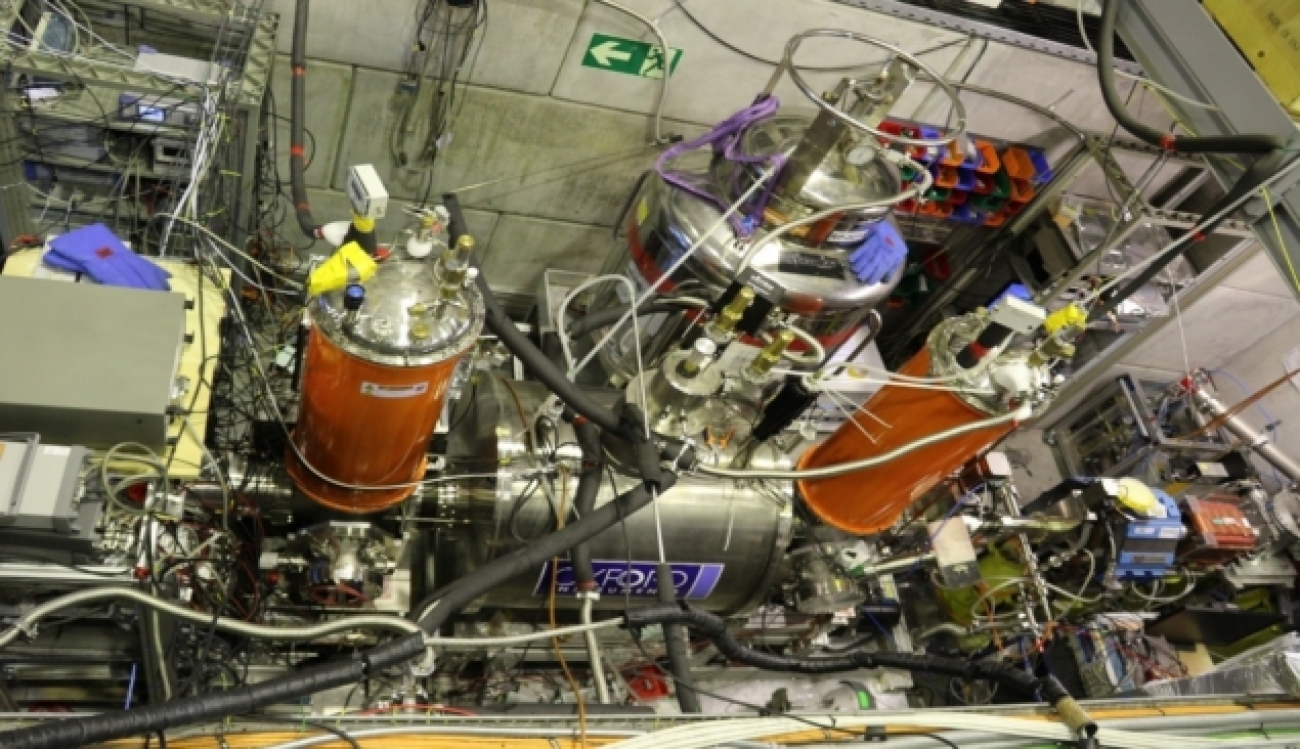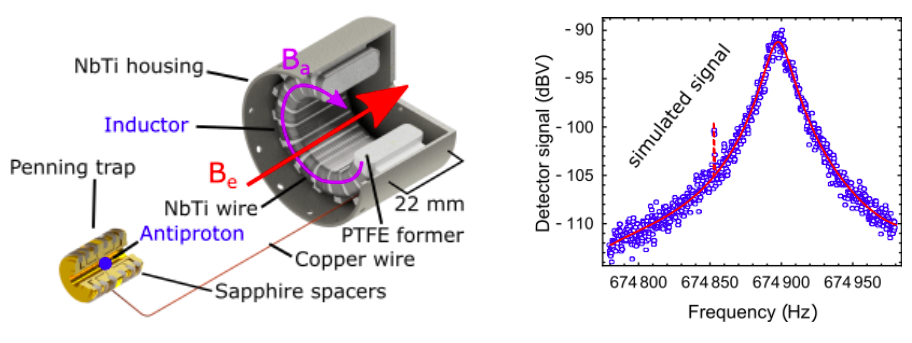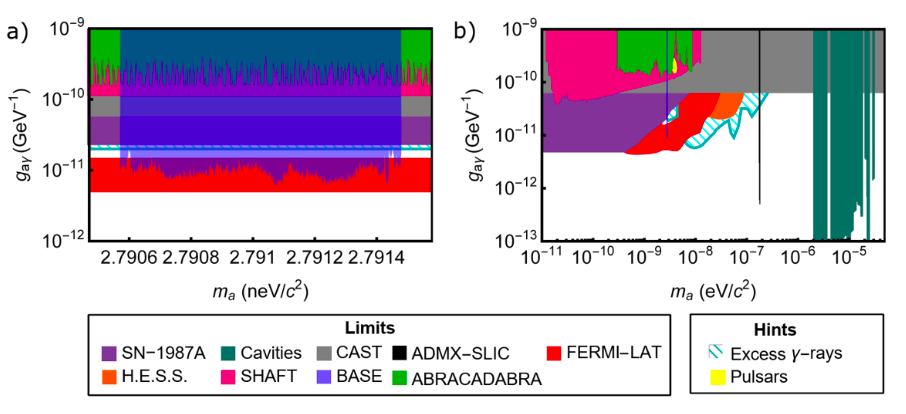BASE develops a new technique to detect ultralight dark matter.

In a recent work published in Physical Review Letters [1], the Baryon Antibaryon Symmetry Experiment (BASE) at CERN has placed new limits on a possible coupling between photons and hypothetical axionlike dark matter particles with masses between 2.7906-2.7914 neV. We evaluated the signals from our resonant detectors--which non-destructively measure oscillation frequencies of single trapped antiprotons confined in the experiment – and hunted for faint signals from axionlike dark matter. No signals were found, but we were able to exclude a new range of axionlike particle masses and coupling strengths. BASE was not purpose built to conduct these investigations, but its extremely sensitive detectors nevertheless demonstrated a good sensitivity compared to dedicated axionlike dark matter haloscopes. We have already begun to develop an apparatus which can cover a much broader range of axionlike particle masses at an improved sensitivity
The BASE experiment
Located in CERN’s antimatter factory, BASE was built to compare the fundamental properties of antiprotons and protons with unprecedented precision [2]. Antiprotons are produced by pair-creation using the PS proton beam, decelerated by the antiproton-decelerator (AD), and injected into the experiment. They are then confined in an advanced Penning trap system- a combination of a strong 1.9 T horizontal magnetic field and electric fields generated by applying voltages to ring-shaped electrodes (a configuration known as a “Penning trap”). Once trapped, it is possible to make precise measurements of the oscillation frequencies of even single antiprotons in the trap as well as their Larmor spin precession frequencies. From these measurements, we can compare the proton-to-antiproton charge-to-mass ratio with 69 parts-per-trillion uncertainty [3], and can compare the antiproton-to-proton magnetic moments with a fractional accuracy on the parts-per-billion level [4]. These are the most precise direct tests of CPT symmetry in the baryon sector.

Figure 1. Left: location of experiments inside the Antimatter Factory. Right: electronic instruments, cryostats, and superconducting magnet of the BASE experiment.
One of the vital ingredients in BASE’s achievements have been ultra-sensitive superconducting single particle detection systems [5]. As the charged antiprotons move in the BASE traps, they induce femto-amp sized image currents in the trap electrodes. The non-destructive detection systems at BASE are a series of superconducting, resonant parallel LC circuits connected to the trap electrodes, whose resonant frequencies match the trapped particle’s oscillation frequencies. On resonance, the detectors present a large effective resistance to the image currents, resulting in voltages which can then be amplified by ultra-low-noise cryogenic amplifiers.

Figure 2. Left: A drawing of the BASE trap and detector. Right: a simulation of the signal that would occur from an axionlike particle decaying in the detector. The sharp peak is the axionlike particle signal, superimposed onto the broader detector resonance.
A cross section diagram of one of the detectors connected to a set of trap electrodes is shown in the left part of Fig. 2. It consists of a toroidal coil of niobium-titanium wire, wrapped around a PTFE former and placed in a niobium-titanium housing. The entire assembly is around the same size as an espresso cup. When cooled down to 4.2 K in the BASE apparatus, the niobium-titanium becomes a superconductor, reaching a Q-factor of 42,000 at a resonant frequency of 674 900 Hz for the detector used in this study. Normally we are concerned about blocking out spurious electromagnetic fields which come from other electrical equipment and could be picked up by this detector, however, in this work we considered more exotic sources - axionlike dark matter.
Axionlike dark matter and its interactions with the BASE apparatus
Uncovering the nature of dark matter, which appears to make up around 27% of the energy content of the universe, is one of the great open questions in physics today. One of the many explanations is that dark matter is made up of a new type of pseudoscalar boson. The most famous of these particles is the axion, which was first suggested to resolve the apparent conservation of CP symmetry in the strong force [6]. In recent years, researchers have expanded their search for ultralight bosonic dark matter to also consider a range of axionlike particles which arise from symmetry breaking in physics beyond the standard model. These particles have the right properties to match the cosmological dark matter, but their mass and coupling strength to photons are unknown [7].
In free space, the axionlike particle’s light mass stops it from spontaneously decaying. However, axionlike particles can absorb photons from a strong magnetic field and decay into photons with a frequency close to their Compton frequency νa=mac2/h of the axionlike particles. We realised that the some of our detectors could detect these photons generated from the decay of axionlike dark matter axionlike particles. Inside BASE’s single particle detector, the direction of the static magnetic field Be and electromagnetic boundary conditions mean that the decaying photons form an azimuthal magnetic field which follows the direction Ba in Fig. 2 [8]. This circulating magnetic field cause the detector to “ring” at the axion frequency, producing the type of signal seen in the right part of figure 2, a sharp peak on the broader LC resonance of the detector.
While the resonant detectors enable the axionlike signal to be detected, the trapped antiprotons also have a vital role to play. By looking at the energy spectrum of a trapped antiproton in resonance with the detector, it is possible to unambiguously determine the detectors’ electronic temperature. This vital parameter makes it possible to establish how large the hypothetically induced axionlike particle decay peak will be, compared to the level of the detector noise. In this respect, the trapped antiproton is used as a single-particle “quantum thermometer”, measuring the temperature of the detection system.

Figure 3. Limits on the axionlike particle-photon coupling.
This model-independent noise-level calibration enables us to derive the axionlike particle-to-photon coupling limits shown in Fig. 3 in blue. While narrow, these limits are stronger than any other laboratory searches in this frequency range and comparable to astrophysical limits set by the Fermi-LAT satellite telescope. We are also able to rule out a small region of masses and coupling strengths which the Fermi-LAT telescope was unable to constrain. The BASE team is currently developing a system with adjustable resonance frequency to investigate an at least 1000-fold broader range of axionlike particle masses, first experiments with newly developed resonators look promising with >1000-fold improved bandwidth and no additional resistive losses. We hope to continue this exciting new avenue for dark matter detection at CERN at considerably increased sensitivity.
References
[1] J. A. Devlin et al., Phys. Rev. Lett. 126 041301 (2021) https://doi.org/10.1103/PhysRevLett.126.041301
[2] C. Smorra et al. Eur. Phys. J. 224, 3055 (2015). http://dx.doi.org/10.1140/epjst/e2015-02607-4
[3] S. Ulmer et al., Nature 524, 196 (2015). http://dx.doi.org/10.1038/nature14861
[4] C. Smorra et al., Nature 550, 371 (2017). http://dx.doi.org/10.1038/nature24048
[5] H. Nagahama et al., Rev. Sci. Instrum. 87, 113305 (2016). http://dx.doi.org/10.1063/1.4967493
[6] R. Peccei, in CP Violation, (World Scientific, Singapore, 1989).
[7] P. Arias et al., J. Cosmol. Astropart. Phys. 2012, 013 (2012). http://dx.doi.org/10.1088/1475-7516/2012/06/013
[8] P. Sikivie, N. Sullivan, and D. B. Tanner, Phys. Rev. Lett. 112, 131301 (2014). http://link.aps.org/doi/10.1103/PhysRevLett.112.131301
